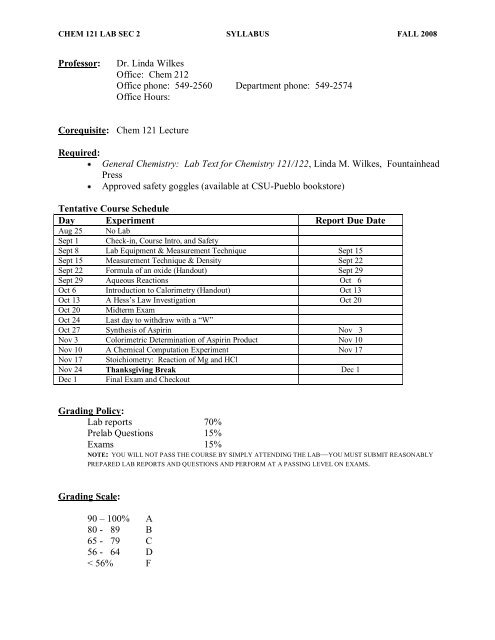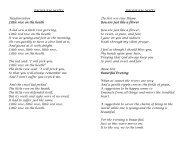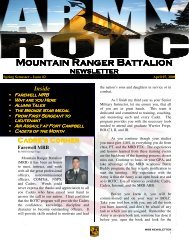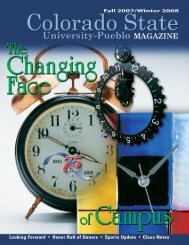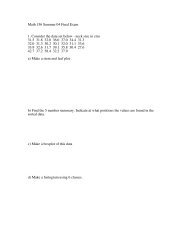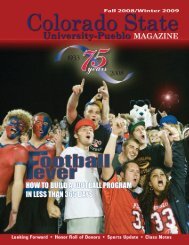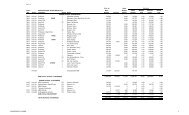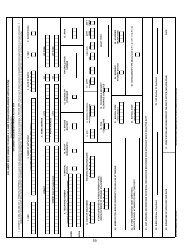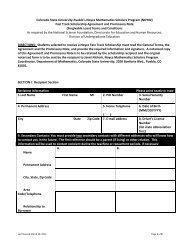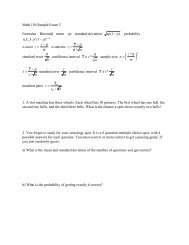SAMPLE LAB REPORT - Colorado State University-Pueblo
SAMPLE LAB REPORT - Colorado State University-Pueblo
SAMPLE LAB REPORT - Colorado State University-Pueblo
Create successful ePaper yourself
Turn your PDF publications into a flip-book with our unique Google optimized e-Paper software.
CHEM 121 <strong>LAB</strong> SEC 2 SYL<strong>LAB</strong>US FALL 2008Professor:Dr. Linda WilkesOffice: Chem 212Office phone: 549-2560 Department phone: 549-2574Office Hours:Corequisite: Chem 121 LectureRequired:General Chemistry: Lab Text for Chemistry 121/122, Linda M. Wilkes, FountainheadPressApproved safety goggles (available at CSU-<strong>Pueblo</strong> bookstore)Tentative Course ScheduleDay Experiment Report Due DateAug 25 No LabSept 1 Check-in, Course Intro, and SafetySept 8 Lab Equipment & Measurement Technique Sept 15Sept 15 Measurement Technique & Density Sept 22Sept 22 Formula of an oxide (Handout) Sept 29Sept 29 Aqueous Reactions Oct 6Oct 6 Introduction to Calorimetry (Handout) Oct 13Oct 13 A Hess‘s Law Investigation Oct 20Oct 20 Midterm ExamOct 24 Last day to withdraw with a ―W‖Oct 27 Synthesis of Aspirin Nov 3Nov 3 Colorimetric Determination of Aspirin Product Nov 10Nov 10 A Chemical Computation Experiment Nov 17Nov 17 Stoichiometry: Reaction of Mg and HClNov 24 Thanksgiving Break Dec 1Dec 1 Final Exam and CheckoutGrading Policy:Lab reports 70%Prelab Questions 15%Exams 15%NOTE: YOU WILL NOT PASS THE COURSE BY SIMPLY ATTENDING THE <strong>LAB</strong>—YOU MUST SUBMIT REASONABLYPREPARED <strong>LAB</strong> <strong>REPORT</strong>S AND QUESTIONS AND PERFORM AT A PASSING LEVEL ON EXAMS.Grading Scale:90 – 100% A80 - 89 B65 - 79 C56 - 64 D< 56% F
CHEM 121 <strong>LAB</strong> SEC 2 SYL<strong>LAB</strong>US FALL 2008CHEMISTRY 121/122Requirements for Lab ReportsThe main reason for the Lab Report is to show your instructor that you understand the experimentand can report on and make sense of your data. To that end, a Lab Report should include:I. A paragraph summarizing the objectives and concepts of the experiment—pretend thatyou are explaining the experiment to your roommate who has not taken any chemistry!o This is NOT COPIED DIRECTLY FROM THE <strong>LAB</strong>ORATORY EXPERIMENT TEXT! It is acompilation of information written in your own words (grammatically correct!) andit should have multiple sources: (1) your instructor’s lecture; (2) your chemistrytext; (3) your laboratory experiment text.II. All data collected—make sure all data is labeled—if it is not labeled, it is notsubmitted. Your data may be submitted directly by using the tear-out data sheets fromyour lab text (make sure they are neat and readable!).III. All calculations, shown clearly! The calculations can generally be on the data sheetswith your data, however, if there is not enough room, you may need to submit an extrasheet of calculations.o The calculations should be organized such that they are easy to follow, show allsteps of the calculations.IV. A paragraph summarizing your results must be included; both qualitative results(observations) as well as quantitative results (numerical).o In addition, you should analyze your results in this paragraph. For example, inone experiment you produced several different graphs by plotting some data indifferent forms. Some graphs were linear, some were non-linear. In your resultsyou state which graphs were linear and which were non-linear. In your analysis ordiscussion of your results, you discuss why a linear relationship in the data isimportant and what it tells you about your data if the graph is linear and if thegraph is non-linear.V. All calculations/answers to any post-lab questions, these may be submitted by using thetear-out post-lab questions in the lab text.
CHEM 121 <strong>LAB</strong> SEC 2 SYL<strong>LAB</strong>US FALL 2008<strong>SAMPLE</strong> <strong>LAB</strong> <strong>REPORT</strong>Vapor Pressure of WaterPart I:(244 words)IntroductionThe purpose of this experiment is todetermine the molar heat of vaporization ofwater ( H vap ) using the Clausius-Clapeyronequation: a(Chapter 11, Brown and LeMay)ln PH vapRTA bwhere P is the vapor pressure of water and T isthe temperature of the water in Kelvin, R is athe gas constant (8.314 J/mol K) and A is aconstant. The Clausius-Clapeyron equationexhibits a relationship between the natural logof the vapor pressure (ln P) of a liquid and thereciprocal of the temperature (1/T) such that byplotting ln P (y-axis) vs 1/T (x-axis) a straightline occurs with a slopeH vapR. In otherwords, the Clausius-Clapeyron equation is inthe form of a straight line (y = mx + b) c .A liquid boils when its vapor pressurematches the prevailing atmospheric pressure soas atmospheric pressure decreases so does thetemperature at which the liquid boils. Thisexperiment will reduce the apparentatmospheric pressure in a closed flask of waterand measure the boiling temperatures of thewater under these different conditions ofapparent atmospheric pressure d . A set ofcorresponding vapor pressure and temperaturevalues will be collected for the water underthese conditions. The collected set of vapora The purpose and concept used is clearlystated. Note that the text book is referencedas being a source of informationb Any mathematical equations or chemicalequations that describe the experiment shouldbe clearly given—not in a text line, but on aseparate line—with symbols definedc The relationship between the purpose(finding H vap ) and the mathematicalrelationship (Clausius-Clapeyron equation) isexplained.d A very brief and conceptual description ofhow the data is to be obtained may benecessary, but any specific experimentalprocedure should not be given in theintroduction.
CHEM 121 <strong>LAB</strong> SEC 2 SYL<strong>LAB</strong>US FALL 2008pressure/temperature data are then plotted e inorder to find the slope of the straight line sothat the H vap can be calculated:H vap = - (slope)(R)The literature value listed for the molar heat ofe Note the use of more formal language here―data are plotted‖ rather than ―we plotted thedata‖.f If there are known or literature values for theexpected results, they should be givenvaporization of water is H vap = 40.67 kJ/mol f .Part II:DataThis section should contain the tear-out datasheets from the lab text and any Excel graphsgenerated.Note: the spacing is 1.5 lines to allow for easierreading, comments and corrections.Make sure all data is given in the correct numberof significant digits and has the appropriateunits.Part III:CalculationsThis section should contain all calculationsnecessary to obtain the experimental resultsfrom the experimental data and should be onthe tear-out data sheets. Extra pages may beincluded for calculations if there is not enoughroom on the tear-out sheets.Calculations should be organized and writtenneatly, showing all units.(278 words)Part IV:Results and DiscussionThe Clausius-Clapeyron equation givesthe relationship between the vapor pressure andtemperature of a liquid a :ln PH vapRTGiven that a liquid boils when its vaporpressure is equal to the atmospheric pressure,we were able to acquire b vapor pressure data atdifferent temperatures by reducing the pressureinside a flask of water and gradually heatingthe water to determine its vapor pressure andAa A brief review of the concepts is appropriate,showing any mathematical or chemical equationsthat are important.b Note the use of first person; for our purposes,the R&D can be written a little more informallythan the introduction, which should be written inthird person.
CHEM 121 <strong>LAB</strong> SEC 2 SYL<strong>LAB</strong>US FALL 2008respective boiling temperature under conditionsof lower apparent atmospheric pressure. Theplot of lnP vs 1/T produced a nearly straightline with a linear best-fit shown by the equationy = - 4635.1x + 18.985 and a correlationcoefficient of R 2 = 0.9989 (1.000 is a perfectfit). The correlation coefficient indicates c thatthe data points fit the straight best-fit line quitewell. The slope of the line (slope = - 4635.1 K)is related to the molar heat of vaporization ofwater:H vap = - (slope)(R)The calculated value of H vap = 38.5 kJ/mol dwas determined from the slope of the plotteddata. The literature value is H vap = 40.67kJ/mol and the error is 5.24% e . It should benoted that the result for the calculated molarheat of vaporization is only as good as the slopeof the best straight-line fit of the data. Inaddition, the calibration of the thermister andthe pressure sensors is extremely important inthe collection of accurate data. If thecalibration of either (or both) of the units isincorrect, a small variation in slope can greatlyaffect the calculated value f (a slope of – 3635 Kinstead of – 4635 K would produce a H vap =30.2 kJ/mol, over 10 kJ/mol lower that theliterature value!).d The slope is given with the final experimentalresult as well as the mathematical relationship.e Since a literature value is known, anexperimental error can be calculated.f There should be a brief discussion of what couldcause error in the experiment—and this is not ―Imisread the balance‖! This should be error that canoccur from conditions in the collection of data andthe processing of the data.Part V:Questions/AnswersPost-lab questions answered and submitted onthe tear-out lab sheet in the lab text.


